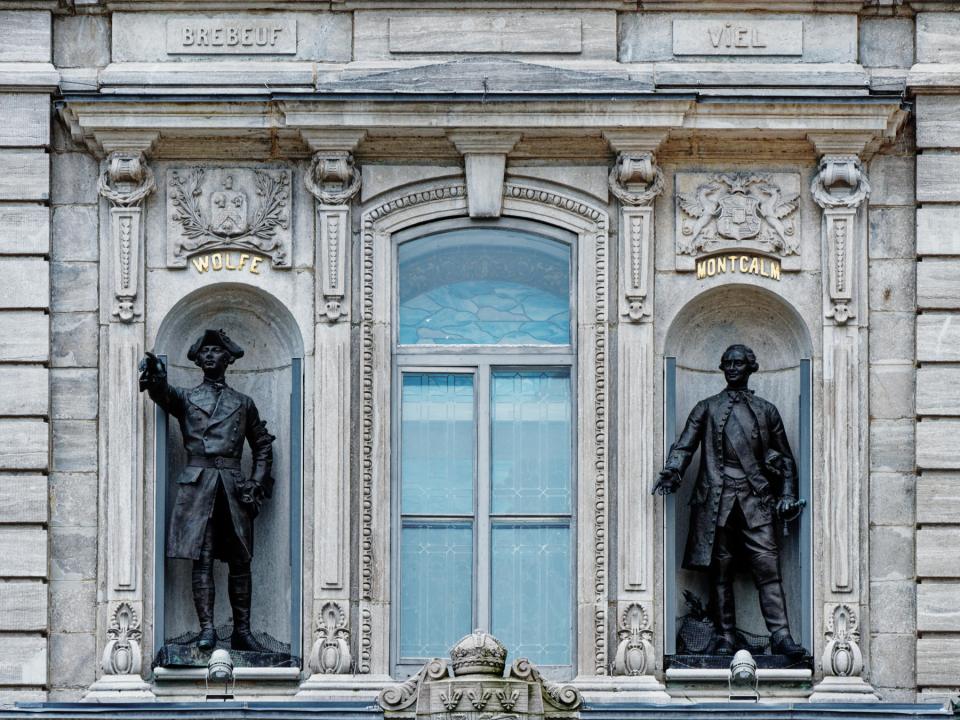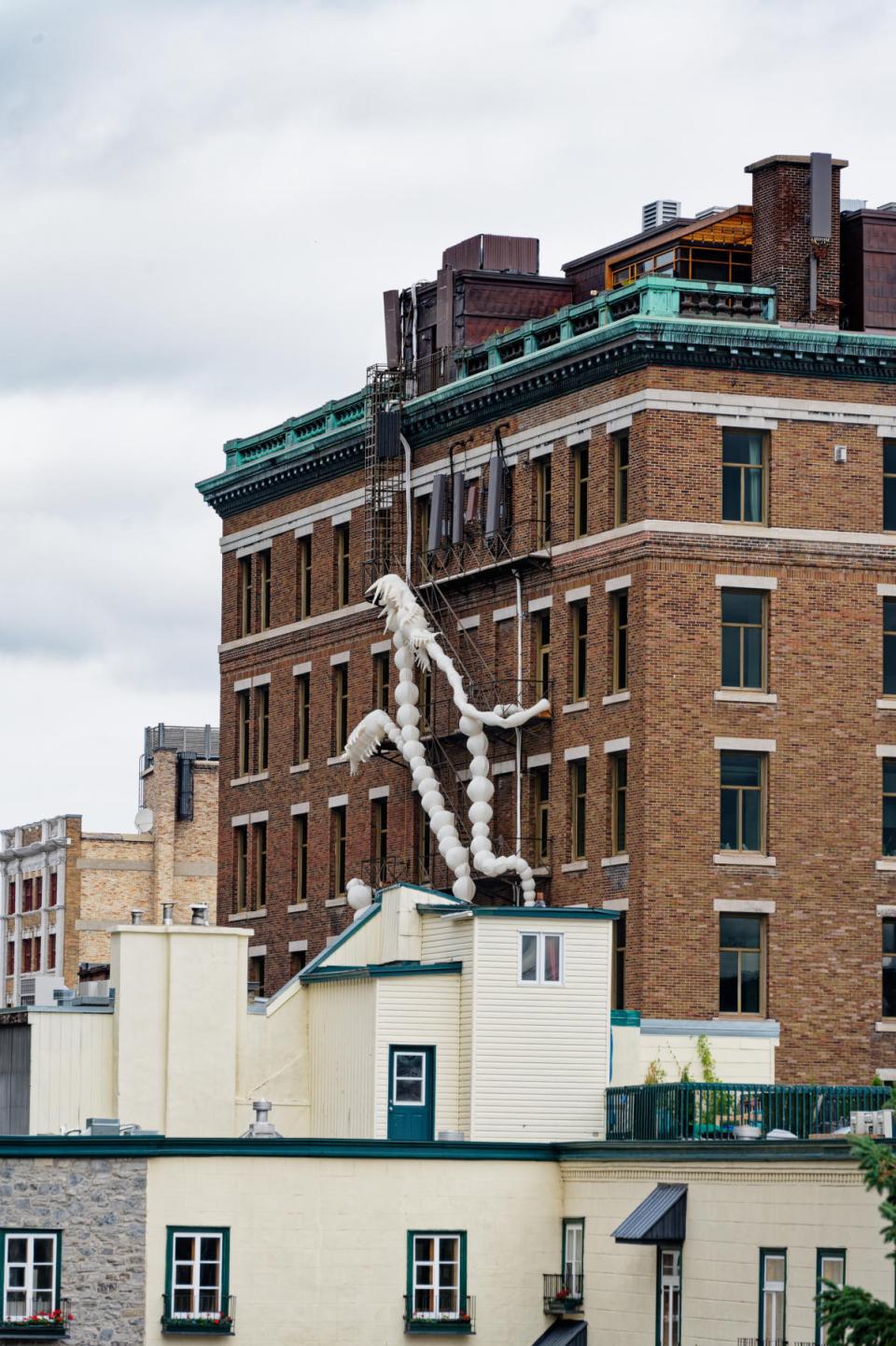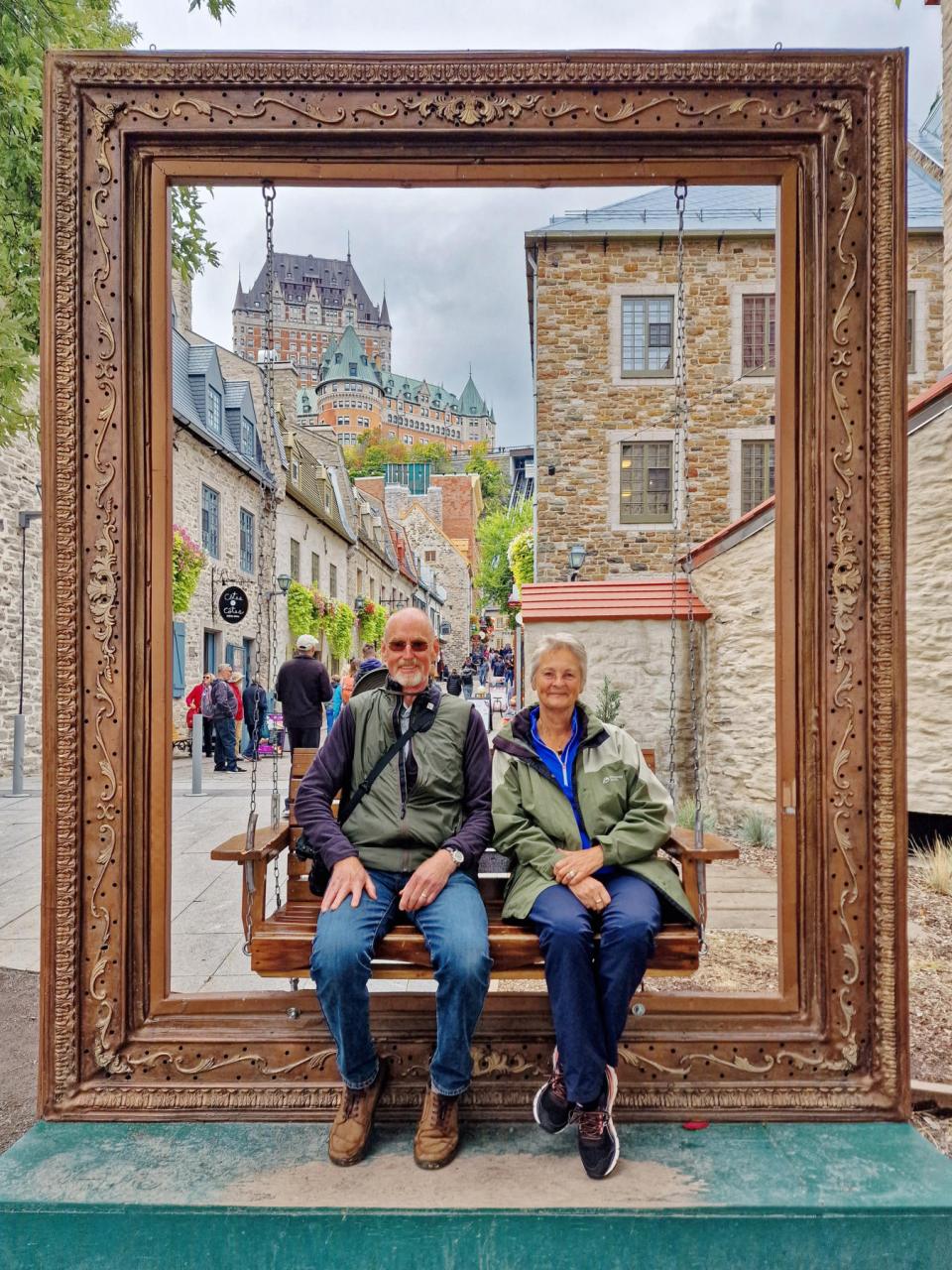Saturday 24 September 2022 – As expected, Jane had formulated A Plan for the day – a walk in the Old Town, followed by a stroll beside a canal which led to the Old Port. Accordingly, we hopped the Metro to Champ-de-Mars (because we’re seasoned users of the public transport now, you see), and attempted to follow a self-guided walking tour that Jane had found on the interweb. This part of the day, overall, was not a success, partly because the route given by the website was either not very good or incoherent (possibly both) and partly because Montreal Old Town is, well, not really very interesting. Perhaps it would have been more rewarding if we’d been able to organise a guide to regale us with fascinating historical and contextual nuggets, but, as it was, we didn’t find much to wow us.
There are some prominent buildings there, such as the Bon Secours market building, with its distinctive silver-coloured dome, which I assume is a tin roof with big ideas.

It looks like the sort of building that should house something monumental or religious, but actually inside it is a modernish market, with boutiquey shops. Even the tourist tat is done quite nicely.


Other major buildings of interest, such as the Town Hall and the Basilica of Notre Dame, are shrouded in scaffolding and other paraphernalia of reconstruction, which renders them less easy on the eye. Next door to the market building is the Notre Dame de Bon-Secours Chapel,

inside which, we were delighted to find, was a chamber trio playing at the far end – rehearsing for a concert, we guessed.
The chapel dates from 1771; it was a popular place of worship for sailors coming to port from the St Lawrence river and it became widely known as the sailors’ chapel. It has a lovely interior

with replicas of ships hanging from the ceiling as a reminder of this heritage.


And, er, that’s it for the Old Town, really. We wandered about the rest of the area trying, and, we eventually realised, failing, to follow the self-guided tour. It had one lighter moment when I spotted an illusion that the figure on top of the chapel was trying to operate a punt,

but beyond the Wheel and the Clock Tower (with the geodesic dome of the Montreal Biosphere museum, designed by Buckmaster Fuller for the US pavilion at the 1967 Expo, visible in the distance)

we couldn’t find anything particularly to detain us beyond this general kind of street scene

It was at this point that we found out that the “Galleon” by the Wheel was a kids’ adventure park.

Having exhausted what we could see of the entertainment possibilities here, we decided to go for Part 2 of The Plan – the Canal. To do this, we hopped the Metro again, to Place Saint Henri, and then walked down to the Lachine Canal, which connects Lake Saint-Louis to the Old Port, our target for the walk. The canal gets its name from the French word for China (la Chine). The European explorers sought to find a route from New France to the Western Sea, and from there to China and hence, optimistically, the region where the canal was built was named Lachine.
Jane had read that the canal had been the subject of some gentrification (not unusual for waterside locations with an industrial history). Initially, there wasn’t much evidence of this, but before too long we saw the unmistakeable signs of what would once have been a warehouse or similar.

This turned out to be Merchants Manufacturing, a mill which has a reasonably chequered history, including being expanded to be the second largest cotton factory in the country. Further investigation showed that it was now a very substantial and not unattractive apartment complex.


The canal then displayed signs that we were approaching another nexus of civilisation

and then we found ourselves at Atwater Market, which is quite substantial and was quite busy.



Just as Jean Talon’s market had introduced us to aubergines and cauliflowers of unfamiliar colours, this one showed that squash can come in a variety of colours

as well as the more common orange of the pumpkin.

Every year I’m astonished by the ubiquity of pumpkins in this season. Surely you can only eat or carve so many? What happens to all the rest?
As we went back to the canal, we passed a “flowerbed” which actually contained only edible plants – a nice touch.

We passed another suburb which had a canal-side chess den

and seemed to be preparing for some kind of local festival.

Evidence of the industrial past increased as we neared the city.

We passed one of the hydraulically-operated locks

which, I was pleased to note, was being kept clear of leaves and other debris by the lock-keeping staff,

something which I wish could happen in the UK, where the appearance of many otherwise charming locks is spoiled by accumulated crud, both natural and man-made.
We also discovered that the canal path was part of the Trans-Canada Trail, the scope of which is absolutely vast –

28,000km in total, meandering all over the vastness of Canada’s interior. To give this some context, the circumference of the earth is just 40,000km.
Further evidence of previous industrialisation mounted as we carried on.




as well as of the gentrification process which is making this walk so much more pleasant.

There is a clear cycle path which is sometimes separate from and sometimes on the same ground as the walking path, thus requiring vigilance on the part of pedestrians wanting to cross the path e.g. to take photos.
The landscape clearly shows what a massively industrial area this once was.




Looking left, we could see the part of the city where our hotel is – you can just spot the dome of its next-door neighbour Basilica among the tower blocks.

There’s a boat converted into a spa

and a clearer view of Habitat 67, a project designed by Israeli-Canadian architect Moshe Safdie and built for Expo 67, a World’s Fair held here from April to October 1967. It comprises 354 identical prefabricated concrete forms, arranged in various combinations and divided into three pyramids (I’ve only shown two here because there was a stack of containers in the way of the third).

Safdie’s goal for the project to be affordable housing largely failed: demand for the building’s units has made them more expensive than originally envisioned. Good old market forces, eh?
And then, there we were, in the Old Port


which gives some views over the city


and even makes the Old Town look reasonably attractive.
By this stage, it was nearly 3 o’clock, and so we decided that an early (for us) lunch was the order of the day. There’s a square in the Old Town, Place Jacques Cartier, which features several restaurants, so we headed there, and Jane suggested we try Jardin Nelson, a restaurant on the ground floor and courtyard of the erstwhile Nelson Hotel – all of which, I suppose, take the name from the version of Nelson’s Column which stands at the top end of the square.

This turned out to be an inspired choice, as we were led to a table in the flower- and greenery-bedecked courtyard


which allowed us to hear the really very good jazz trio who were performing

without being overwhelmed by their volume. We had an excellent poké bowl lunch and then tottered back to our hotel, once again via the good services of the Metro.
And that was it for Montréal, really – a city whose undoubtedly charming scenes just fail to overcome the downside of the scruffiness, graffiti and quotient of beggars and derelicts of the place. It occurs to me that we visited these eastern cities in the wrong order, largely as a consequence of our itinerary evolving over the space of three years, getting modified every time the trip was rescheduled. Our route (you’ll remember, because you’ve been paying attention) has been from Ottawa to Québec City to Montréal. I think a better (and more logical) route would be Ottawa – Montréal – Québec City, where the charm of the final destination might erase the less-than-distinguished memories from its predecessor.
Tomorrow sees an interruption to our eastward peregrination, as we head back to Winnipeg as part of ticking an important tourist box. It involves an early start. To find out more, please join us over the next few days. See ya later!














































 If you look carefully, you can see a cross between the two arches, betraying Christian influences.
If you look carefully, you can see a cross between the two arches, betraying Christian influences.


 seen here with the alarm sensor that Jane triggered when gesturing to a detail on the coffin. But the minders let us off with a mild beating and we went on our way.*
seen here with the alarm sensor that Jane triggered when gesturing to a detail on the coffin. But the minders let us off with a mild beating and we went on our way.*


















